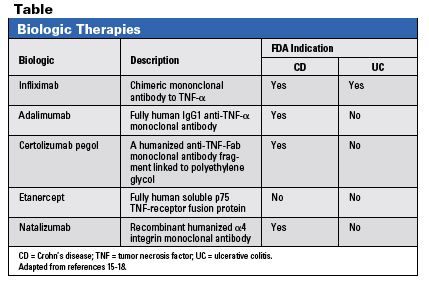Publication
Article
Pharmacy Times
Inflammatory Bowel Disease
Author(s):
Dr. Grandinetti is a senior clinical research pharmacist at the National Cancer Institute, National Institutes of Health, Rockville, Maryland. The views expressed are those of the author and not those of any government agency.
Inflammatory bowel disease (IBD) is an idiopathic chronic disorder with a relapsing and remitting course.1 Crohn's disease (CD) and ulcerative colitis (UC) fall under IBD's umbrella, but have different pathogeneses, inflammatory profiles, symptoms, and treatment regimens. CD is characterized by inflammation that penetrates the cell wall and may affect any portion of the gastrointestinal (GI) tract from the mouth to anus; UC is associated with inflammation penetrating the mucosa, but restricted to the colon.2,3
IBD's prevalence is higher in developed countries. Increased sanitation and westernized lifestyles appear to increase the risk of developing IBD. One theory postulates that exposure to less sanitary conditions during development optimizes mucosal immune development, preventing future inflammatory response.4
IBD may result from abnormal GI inflammatory and immune response to microbial, dietary, and autoimmune proinflammatory antigenic triggers.1 Smoking and nonsteroidal anti-inflammatory drugs (NSAIDs) are among the environmental factors that can modify IBD's course. CD is more than twice as likely to develop in smokers, and its recurrence rate is higher than in nonsmokers.5,6 In CD, smoking promotes fistula and stricture formation, increases exacerbation rates and corticosteroid requirements, and accelerates the need for resurgery after surgicallyinduced remissions. Conversely, smoking provides a protective effect and is associated with fewer exacerbations in UC.1 Smoking cessation appears to be an effective therapeutic intervention in CD, but fails to show efficacy in UC.7,8 Clinicians should, however, encourage all IBD patients to stop smoking.
NSAIDs exacerbate IBD by causing strictures, obstruction, perforation, and hemorrhage. Studies suggest that prostaglandin synthesis inhibition may be the mechanism.3 IBD patients should use acetaminophen rather than NSAIDs for pain relief.
IBD can occur at any age but peaks in the second and third decades of life. Clinical features and symptoms vary according to disease severity. In CD, features also vary according to anatomic location (small bowel, ileum, or colon) (Table).1-3,9,10 Both are associated with extraintestinal complications such as obstructions, strictures, fissures, abscesses, fistulas, toxic megacolon, anemia, and skin, eye, and joint problems.3 Colorectal cancer risk is elevated, with the incidence higher in UC than CD patients.11
Treatment goals are to induce and maintain remission, prevent complications, minimize toxicities, and improve quality of life.3,9 Clinicians should select therapy based on disease location in the GI tract, extent, and severity. The disease location and the drug's pharmacokinetic profile may impair drug absorption.
Treatment Options for Different Health Care SettingsAmbulatory Care Setting and Long-Term CareDepending on disease location, mild-to-moderate IBD is treated initially with oral or topical aminosalicylates (sulfasalazine or mesalamine) or oral corticosteroids. Aminosalicylates are limited by their adverse effects, which are generally dose-related: headache, nausea, epigastric pain, and diarrhea. Patients with moderately active disease who are unresponsive or intolerant to aminosalicylates require oral corticosteroids.3
Corticosteroids are the mainstay of treatment for inducing remission rapidly.3,12 Dependence and adverse effects (eg, weight gain, round face, acne, muscle cramps, lower extremity edema, thin skin, decreased wound healing, and osteoporosis), however, limit their long-term use. Budesonide, an oral corticosteroid with limited bioavailability due to extensive first-pass hepatic metabolism, is an option for patients who experience significant steroid-related adverse effects.13 Periodically monitor blood glucose, bone mineral density, and perform ophthalmologic exams in patients on long-term therapy.13
Immunomodulators (azathioprine, 6-mercaptopurine, and methotrexate) are often added to decrease corticosteroid requirements in patients who relapse on aminosalicylates or are steroid dependent.2,13
Despite conflicting evidence, clinicians often prescribe antibiotics (metronidazole and ciprofloxacin) because enteric microflora is thought to be partly causative. Mechanism of action is poorly understood, but they may decrease microbial-induced inflammation and suppress the mucosal immune system.2
Newer biologics have introduced new treatment options for IBD. Tumor necrosis factor (TNF)-a is the key inflammatory cytokine implicated in IBD's pathogenesis. The TNF-a antagonists, infliximab, adalimumab, certolizumab pegol, and etanercept, are available for the treatment of IBD. Although there are long-term safety concerns, TNF-a antagonists are used in patients who are refractory to conventional therapies.11,14 Adalimumab and certolizumab pegol are alternatives in patients refractory to infliximab. Natalizumab is a humanized monoclonal antibody against the cellular adhesion molecule a4 integrin. It is an effective alternative for patients refractory or intolerant to conventional therapies and TNF-a antagonists.15
All agents are administered in an outpatient setting as subcutaneous injections except infliximab and natalizumab, which are infused intravenously. Due to infusion-related and delayed hypersensitivity reactions, observe patients at least 1 hour after drug administration. Acetaminophen, antihistamines, corticosteroids, and epinephrine should be available for immediate use in the event of a hypersensitivity reaction. Discontinue therapy for severe hypersensitivity reactions.15-18
Specific TNF-a antagonist safety concerns include serious infections leading to hospitalization or death and hepatitis B and tuberculosis reactivation. Closely monitor and educate patients about the signs and symptoms of infection during and after treatment.16-18 Natalizumab increases the risk of progressive multifocal leukoencephalopathy, an opportunistic viral brain infection, and thus, is available only through a restricted distribution program.15
Hospital SettingApproximately 60% of patients will require surgery within 10 years of initial symptoms. Surgery is indicated in patients with life-threatening complications, who become refractory or intolerant to drug therapy, or when the goal is to reduce colon cancer risk.2 Patients with severe colitis or moderate disease who fail to respond to steroids within 2 weeks will be hospitalized.
Hospitalized patients generally require aggressive fluid and electrolyte replacement. Intravenous (IV) corticosteroids are used to induce remission in patients with severe or fulminant disease or limited GI absorption. IV cyclosporine or tacrolimus are effective alternatives. Switch patients to oral therapy after 7 to 10 days if improvement is noted. Infliximab is an alternative to IV corticosteroids, or in corticosteroid-refractory patients. Patients with significant anemia may require blood transfusions. Obtain blood cultures and start broad-spectrum antibiotics in patients who are febrile and have leukocytosis. Bowel rest and nutritional support are recommended in patients who are unable to maintain adequate nutrition for longer than 5 to 7 days or who have toxic megacolon where surgery might be imminent.2
All Health Care SettingsPatients should minimize exposure to aminosalicylates and corticosteroids during pregnancy. Pregnant women taking sulfasalazine should take folic acid 1 mg twice daily. Advise patients to avoid azathioprine, 6-mercaptopurine, cyclosporine, and methotrexate during pregnancy because of fetal growth retardation risk, prematurity, and congenital malformations.
Antidiarrheals and antispasmodics provide symptomatic relief in mild disease, but should be used cautiously. Antidiarrheals may precipitate toxic megacolon, and antispasmodics should be avoided in patients with intestinal obstruction or severe disease. Colonoscopy with biopsy is recommended every 1 to 2 years in most patients with extensive colitis of 8 to 10 years. Monitor patients closely for drug efficacy, adverse events, and nonadherence. Improve adherence by choosing therapeutic regimens with less frequent dosing intervals and more palatable dosage forms (eg, oral vs rectal).2 Educating patients on their disease, drug therapy, and drug-specific adverse effects improves patient care and outcomes.


References
1. Baumgart DC, Carding SR. Inflammatory bowel disease: cause and immunobiology. Lancet. 2007;369(9573):1627-1640.
2. Baumgart DC, Sandborn WJ. Inflammatory bowel disease: clinical aspects and established and evolving therapies. Lancet. 2007;369(9573):1641-1657.
3. Fow J, Grossman S. A comprehensive guide to patient-focused management strategies for Crohn disease. Gastroenterol Nurs. 2007;30(2):93-98.
4. Geier MS, Butler RN, Howarth GS. Inflammatory bowel disease: current insights into pathogenesis and new therapeutic options; probiotics, prebiotics, and synbiotics. Int J Food Microbiol. 2007;115(1):1-11.
5. Sutherland LR, Ramcharan S, Bryant H, Fick G. Effect of cigarette smoking on recurrence of Crohn's disease. Gastroenterology. 1990;98(5 Pt 1):1123-1128.
6. Silverstein MD, Lashner BA, Hanauer SB, Evans AA, Kirsner JB. Cigarette smoking in Crohn's disease. Am J Gastroenterol. 1989;84(1):31-33.
7. Cosnes J. Tobacco and IBD: relevance in the understanding of disease mechanisms and clinical practice. Best Pract Res Clin Gastroenterol. 2004;18(3):481-496.
8. McGrath J, McDonald JW, MacDonald JK. Transdermal nicotine for induction of remission in ulcerative colitis. Cochrane Database Syst Rev. 2004;(4):CD004722.
9. Collins P, Rhodes J. Ulcerative colitis: diagnosis and management. BMJ. 2006;333(7563):340-343.
10. Baudet A, Rahmi G, Bretagne AL, Gloro R, Justum AM, Reimund JM. Severe ulcerative colitis: present medical treatment strategies. Expert Opin Pharmacother. 2008;9(3):447-457.
11. Biancone L, Calabrese E, Petruzziello C, Pallone F. Treatment with biologic therapies and the risk of cancer in patients with IBD. Nat Clin Pract Gastroenterol Hepatol. 2007;4(2):78-91.
12. Sands BE. Inflammatory bowel disease: past, present, and future. J Gastroenterol. 2007;42(1):16-25.
13. Lichtenstein GR, Abreu MT, Cohen R, Tremaine W. American Gastroenterological Association Institute technical review on corticosteroids, immunomodulators, and infliximab in inflammatory bowel disease. Gastroenterology. 2006;130(3):940-987.
14. Kozuch PL, Hanauer SB. General principles and pharmacology of biologics in inflammatory bowel disease. Gastroenterol Clin North Am. 2006;35(4):757-773.
15. Tysarbri [package insert]. South San Francisco, CA: Elan Pharmaceuticals Inc; 2008.
16. Remicade [package insert]. Malvern, PA: Centocor Inc; 2008.
17. Humira [package insert]. North Chicago, IL: Abbott Laboratories; 2008.
18. Enbrel [package insert]. Thousand Oaks, CA: Immunex Corporation; 2008.







